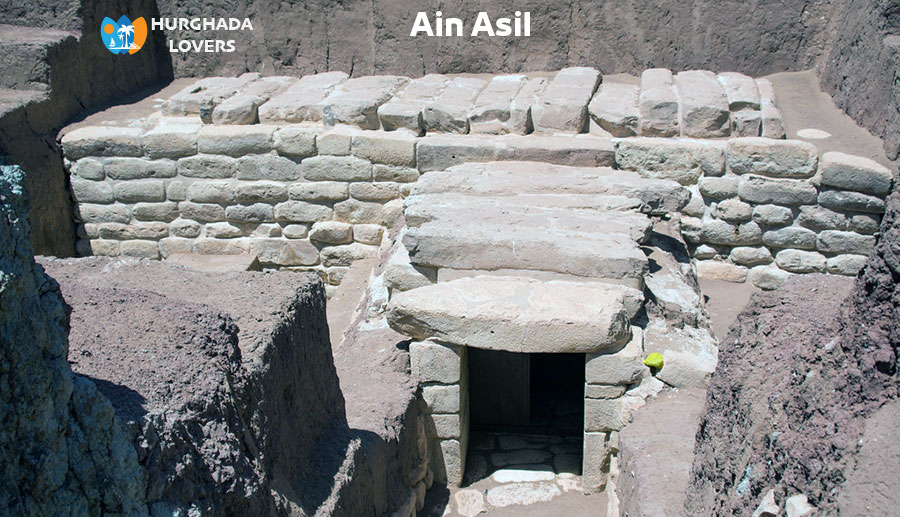Ain Asil in Dakhla Oasis, Egypt | Facts Ayn Asil, History Pharaonic Archaeological Sites in Balat, New Valley Governorate, Map Qila el-Dab’a, Entrance Fees, Opening Hours and more…
The facts of the terraces of the castles of the Dabba, the history of the most important Pharaonic archaeological sites in the oases, the price of the entrance ticket, working hours and more.
Ain al-Aseel Castle is an archaeological site located in the ancient Egyptian city of tiles in the Dakhla Oasis, in the New Valley Governorate.
Also, in the past, the palace and settlement were built in that area for the local ruler responsible for taking over the rule in the Sixth Egyptian Dynasty.
Also, that cemetery or settlement was located approximately one kilometer to the west of Qalaat al-Dabaa, so they are considered the same area.
Also, all these evidences found in the northeastern area of Al-Balat are among the oldest of those important archaeological monuments that express the ancient Egyptian state in the Western Desert.
It also testifies to the great and historical importance of the court area as it is the very important administrative center in taking over the rule of the ancient Egyptian kingdom.
Hurghada lovers Offer Luxury Hurghada to Pyramids Tours | El Gouna to Pyramids Tours | Makadi bay to Pyramids Tours | Sahl Hasheesh to Pyramids Tours | Soma bay to Pyramids Tours .
Ain Asil
When was this archaeological site discovered?
● In fact, this great or local Egyptian archaeological site was only discovered in January 1947 by a large and unprecedented sandstorm.
● Also, in October 1968, the first type of excavation that helped excavate was carried out by Ahmed Fakhry, an expert in ancient Egyptian antiquities and Egyptology, in the period from (1905-1973).
● Not only this, but the walls made of bricks, made of pottery, and some of the stone blocks inscribed in that period had been discovered, as was the discovery of that tomb in the area of the original castles, which bears the name of the king or the owner of the throne, Neferkare, nicknamed: (Baby II).
● Work in that area also stopped after Fakhri’s death, and then Kallen resumed work in that area in 1978 by men and specialists from the French Institute of Oriental Archeology in the Cairo area.
History and description
● In fact, the settlement of Ain Al-Aseel is considered something very special and one of the most important discovered Egyptian monuments, because it is a large settlement of this size and flourishing in that impressive form and at the same time far from the Nile Valley.
● On the other hand, the state in which it was preserved is very good, a state in which all scholars had already been able to study that ancient city that expresses the rule in the ancient Egyptian kingdom and study the tomb built at that time in the area of castles Hyena too.
Ain al-Aseel settlement
● In fact, that city was an ancient pharaonic city already existing among the kings in the late Fifth Dynasty of Egypt and also included the kings in the early Sixth Dynasty with them after that kings and rulers in the second transitional period.
● Also, during that time there were a large number of the most important settlement stages in which those buildings were actually built and fully constructed.
● Unfortunately, that first phase ended after about three generations due to the presence of severe fires that broke out inside the palace and in a number of other parts of the settlement, but the settlement continued to be used after that despite that fire.
The monuments located in Ain Asil from the south
● In fact, one of the most important and recent discoveries that were found in the Ain al-Aseel area was a group of inscribed blocks, whether from columns or tombs.
● A collection of male witnesses dating back to the eighteenth and nineteenth dynasties in what was known as the (Egyptian Empire).
● The site of the castles of Ain Al-Aseel region, which was originally only a wall, but fortified in a certain shape and small in size.
● It then included a rectangular area which was approximately 33 hectares in size, and was actually divided into two separate parts.
● The nearest area is the castle to the north, with a mudbrick settlement extending to the south and east of this.
● The Ain Al-Aseel region was an administrative center in the Dakhla region, and that was during the reigns of King Bibi I and King Bibi II.
● It seems already that most of that city was destroyed by those fires as we mentioned at the end of the era of the ancient Egyptian kingdom and it was abandoned a very long time ago for some time.
● It also presents a rare discovery in the area of the castles of Ain Al-Aseel, which is a number of clay tablets and engraved at the same time with impressive inscriptions, and its pharaonic history dates back to the era of the Sixth Dynasty.
● Mat Saqib is the oldest growing and emphasizing evidence that this oasis of Dakhla was associated with the Nile Valley region at that time.
● These tablets also contain the names of a number of rulers in the Bahariya Oasis area and a number of their families, in hieratic script.
What is the price of a ticket to visit Ain Asil for the Egyptians?
● The fee for a visit ticket to Ain El-Asil for adults is 10 Egyptian pounds
● As for the ticket fees for visiting Ain Al-Asil for Egyptian students, it is: 5 Egyptian pounds
What is the price of a visit ticket to Ain Al-Aseel for foreigners?
● The fee for a visit ticket to Ain Al-Asil is 40 Egyptian pounds
● If the visitor is a foreign student, the entrance fee is 20 Egyptian pounds

